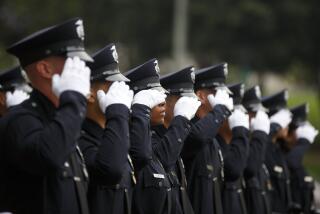When Does Free-Lancing Cross the Conflict Line?
- Share via
KNSD-TV(Channel 39) reporter Michael Settonni was so pleased with a recent free-lance assignment he and station photographer Bill Kuklinski received from the public relations agency Hill & Knowlton that he sent a letter to agency executives soliciting more work.
“We are anxious for our next video assignment with Hill and Knowlton,” he wrote. “We set out to prove to you we are professionals who can offer top-quality video services, without robbing the bank. Keep us in mind for your next event.”
Hill & Knowlton, one of the largest agencies internationally, hired Settonni and Kuklinski to do interviews with players during the Mazda Tennis Classic at La Costa and to prepare video packages for the agency to send out worldwide.
The arrangement was interesting for two reasons: For one, it illustrates a consistent problem for members of the local video industry, who complain that station employees undercut their business by offering services at greatly reduced prices, since the station staffers can use company equipment and have virtually no overhead.
That Settonni took such a job made the assignment particularly noteworthy. Most stations forbid reporters to work for public relations agencies, fearing even the appearance of a conflict of interest.
Settonni didn’t do any on-air work for Hill & Knowlton, but he helped coordinate the video coverage for the public relations agency. He said he “rarely” does free-lance work and felt there was no conflict of interest, since it was a sports event and he covers the environment for Channel 39.
“In no way would I deal with any client even remotely related to my beat,” he said.
But Hill & Knowlton has clients in a wide variety of areas. And in the letter, which Settonni acknowledges writing, Settonni made it clear that he was trying to build a working relationship with the agency.
“We feel we not only were part of the team, but we made some friends too,” he wrote.
No one is suggesting that Settonni’s credibility or integrity was compromised. But, if the station were to suddenly do a feature on a Hill & Knowlton client, it might raise some sticky questions. The other local stations say they forbid reporters from working directly with public relations firms in order to avoid just that type of situation.
“As a general rule, we don’t approve of reporters working for public relations agencies,” said Channel 39 news director Irv Kass, who until informed otherwise thought Settonni contracted with a local video producer for the tennis tournament. “But in certain circumstances it may be appropriate,” primarily in situations involving charities or where there is no compensation involved, he said.
The free-lance activities of staffers have long been a source of debate at local stations, primarily because of the wear and tear on equipment, and the time staffers spend on projects. KFMB-TV (Channel 8) recently told its photographers that they could no longer use station equipment for free-lance projects.
At the other local stations, the practice is generally discouraged, although it is not uncommon.
“We don’t have a problem with it because we don’t do a lot of it,” said Dan Mendez, director of news services at Channel 39, although sources dispute that, saying the practice is widespread at the station.
At most stations it is inevitable that photographers will do free-lance work. And, as long as it doesn’t interfere with station activities, most see it as a way for under-appreciated staffers to make some extra money.
But that doesn’t appease members of the local video industry, who make a living from independent assignments. They view the station staffers as unfair competition, since they have jobs and often don’t have to pay for equipment.
They “can kill your business,” said one local video professional, who asked that his name not be used. “It irritates me that I have to compete with people making a full-time living” working at television stations.
The Arbitron ratings for July, released last week, didn’t bring good news for the new Channel 8 news team. Arbitron shows Channel 8 solidly in third place at 11 p.m. with a 4 rating and 13 share, with Channel 39 moving into second place with a 6 rating and 21 share. Channel 10 is in first place with a 7 rating and 26 share.
Channel 8 is still in second place at 5 p.m., three rating points ahead of Channel 39, but four points behind Channel 10.
Obviously, a certain amount of drop is to be expected, considering all the changes Channel 8 has been making. And Channel 8 is trying to build consistency, which takes time. But the numbers suggest that the audience’s initial reaction to the station’s new lineup is, to say the least, less than enthusiastic.
Beginning Sept. 30, Cox Cable will broadcast a live, 30-minute news broadcast at 10 p.m. produced by the Channel 8 news team. Airing on Cox Cable’s Channel 13, it will feature the same Channel 8 lineup that is now struggling at 11 p.m. Cox and Channel 8 will split revenue from the program. It is an interesting concept, fraught with ramifications, especially for the KUSI-TV (Channel 51) news team, which is billed as San Diego’s only 10 p.m. news program. . . A syndicated talk show featuring Channel 39 tabloid crime reporter Paul Bloom appears to be in television limbo. Multi-Media Productions, producers of the “Sally Jessy Raphael Show,” had hoped to test the concept in at least one city this fall. But producer Burt DuBrow said they still don’t have a market lined up, although he is not giving up. . . .
Kurt Snider, executive producer of Channel 39’s successful “Third Thursday” program, has resigned to pursue his career in Los Angeles. His fiancee, former Channel 39 reporter Rory Bennett, recently landed an associate director job with “Entertainment Tonight.”
More to Read
The biggest entertainment stories
Get our big stories about Hollywood, film, television, music, arts, culture and more right in your inbox as soon as they publish.
You may occasionally receive promotional content from the Los Angeles Times.










